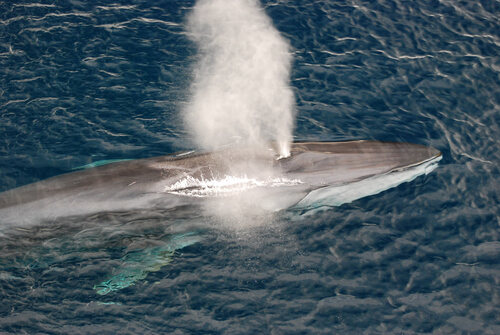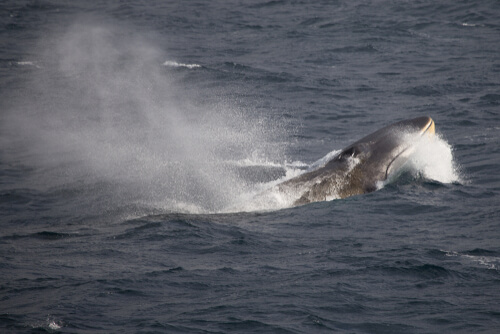
| Kingdom | Animalia |
| Phylum | Chordata |
| Class | Mammalia |
| Order | Artiodactyla |
| Family | Cetacea |
| Genus | Balaenoptera |
| Species | B. physalus |
| Subspecies | B. p. physalus, B. p. quoyi |
| Niche | Pelagic baleen whale |
| Length | 90 ft (27 m) |
| Weight | 126 tons (114 tonnes) |
| Lifespan | 80-90 years |
| Social Structure | Complex family groups |
| Conservation Status | Endangered |
| Range | All oceans besides the Arctic Ocean |
| Average Number of Offspring | 1 |
| Main Prey Species | Krill |
| Predators | Humans, orca |
The Basics
The fin whale is a large species of baleen whale that is present in almost all of the world’s oceans. This humongous animal can live for up to 90 years and grows to almost 90 feet long, making it one of the largest animals to have ever lived on earth, second only to the blue whale, with which it shares a genus.
Description
The fin whale is truly enormous, growing to nearly 100 feet long and weighing about 190 tons. Like other baleen whales, females are typically larger than males. This makes it the largest species of animal to ever live on earth. The whale has a long, narrow body towards its posterior and tail. Their skin is a mottled brownish-gray color, with lighter tinting on their ventral side (underside). They have two large pectoral fins and a large mouth lined with baleen plates used for feeding on krill and other zooplankton.
Distribution and Range
Fin whales are present in much of the world’s oceans, excluding only the extreme polar regions. They normally move between their summer feeding grounds in the north or south and their breeding grounds closer to the equator during the winters. There is a North Atlantic population that occurs between the Gulf of Mexico and the Meditteranean Sea, northward to Baffin Bay and Spitsbergen. In the North Pacific, fin whales inhabit the waters between Baja California, Mexico, and Japan, northward to the Chukchi Sea and the Arctic Ocean. They are often seen along the west coast of North America in California, Oregon, and British Columbia, as well as in the Gulf of Alaska. They have also been observed feeding south of Hawaii, leading some researchers to believe some fin whales migrate there in the fall and winter to breed and nurse their young.

Fin whales are also observed in the south Pacific Ocean, although even less is known about their migrational patterns here. They are seen relatively often near New Zealand as well as along the west and south coasts of South America, such as in Peru and Chile. Fin whales also occur further south near Antarctica and are also observed in the Indian Ocean near the coastlines of Sri Lanka, India, and Malaysia.
Fin whales require a lot of food to maintain their massive size and their movements are largely driven by this necessity. They are often found in waters where their prey is highly concentrated at the time, such as the notoriously bountiful summer months at higher latitudes.
Diet and Predators
Fin whales migrate around the oceans in search of food, likely spending their summers in higher latitudes. They feed on small schooling fish, squid, and various crustaceans including copepods and krill – small, shrimp-like organisms that are part of the plankton. Fin whales and other baleen whales have long plate-like structures in their mouths that they use to filter their food from the water as they swim. They move through large schools of prey with their mouths open, gathering up whatever they can, including water. Then, they will close their mouth and push the water out with their tongues while the baleen plates contain their food.
To maintain its massive size, the fin whale must eat thousands of pounds of food daily. Indeed, during the feeding season, some individuals may consume 4-6 tons of each day for several months. Although their migration patterns are poorly understood, fin whales likely travel between productive polar waters in the summer and more tropical regions during the winter where they give birth and nurse their calves, often searching for food along the way.

The adult fin whale faces few natural threats from predators due to its massive size. On occasion, orcas will attack fin whales as a group, focusing particularly on calves and younger individuals.
However, once abundant in all of the world’s oceans, by the end of the 19th century, the fin whale was hunted nearly to extinction by whaling fleets. Between 1904 and 1975, more than 700,000 fin whales were killed in Antarctica alone. Between 1910 and 1989, another 55,000 were killed in the North Atlantic Ocean.
Reproduction
Fin whales are often solitary but are sometimes found in pairs or small groups of 6-10 individuals. Relatively little is known about their life history, but it is believed that they live for over 90 years and reach sexual maturity at about 15-30 years of age.
The gestation period for fin whales is 10-12 months. Mothers give birth to one calf which she nurses for up to 7 months. The calf is likely weaned while traveling towards their summer feeding grounds but may continue to travel with its mother’s group for several years before reaching sexual maturity itself.
Conservation
The fin whale’s conservation status is often difficult to assess due to limited knowledge of the species’ life history. However, given its slow reproductive rate and various threats from humans and climate change, the species is considered Endangered on the IUCN Red List of Threatened Species.
Fin whales face many known threats. Despite the ban on hunting the species imposed in the 1970s and 80s, it still faces many anthropogenic (man-made) challenges. For example, Iceland and Norway have objected to the International Whaling Commission’s moratoriums, and continue to hunt fin whales in limited numbers. Vessel strikes are relatively common and can injure or kill whales of many species, including fin whales. They are also prone to entanglement with abandoned fishing gear which can reduce their feeding ability, ultimately leading to starvation. Noise pollution in the ocean from human navigations and communications systems is also a threat as it disrupts the whale’s migration patterns and ability to communicate with each other. And finally, like many other species, the effects of climate change are detrimental to the species.
Fun Facts about the Fin Whale!
The fin whale is not nearly as famous as the closely-related blue whale. However, it is nearly as large and has a similar streamlined body shape. Indeed, there are many fun facts to explore through this species, the second largest animal on the planet.
Parasitized
Despite their large size, fin whales suffer from parasitization by several other organisms, most of them small. Parasitic copepods such as Pennella balaenopterae are often found on the sides of fin whales. Here, they burrow into their blubber and feed on their blood of the whale.

Other species such as the pseudo-stalked barnacle Xenobalanus globicipitis are generally found on the fins and flukes of fin whales. Other barnacle species found on fin whales include the acorn barnacle Coronula reginae, normally found on the skin of fin whales, and the stalked barnacle Conchoderma auritum, which often attaches itself to the baleen of the whale or to the acorn barnacle itself.
Even more harmful to fin whales is the harpacticoid copepod Balaenophilus unisetus. Heavy infestations of this species have been observed in fin whales caught off northwestern Spain. Haematophagus spp., which also colonizes the baleen of fin whales, feeds on the whale’s red blood cells while B. unisetus actually feeds on the baleen itself.
The remora (Remora australis) and the amphipod Cyamus balaenopterae are also found on fin whales, feeding on their skin. The giant nematode (Crassicauda boopis) colonizes the blood vessels of whales and can cause inflammation of the renal arteries and potential kidney failure. Its smaller cousin C. crassicauda infects the lower urinary tract and can cause various associated health problems.
The Lowest Frequency
Like other whales, males make long, loud, low-frequency sounds. Indeed, the vocalizations of blue and fin whales are the lowest-frequency sounds made by any animal. Most sounds are frequency-modulated (FM) down-swept infrasonic pulses from 16 to 40 hertz, often below the audible range of humans.
In fact, when fin whale sounds were first recorded, they did not realize that these unusually loud, long, pure, and consistent vocalizations were being made by whales. At first, they suspected that the sounds were due to an equipment malfunction, geophysical phenomena, or even part of a Soviet Union Navy operation. Eventually, biologists demonstrated that the sounds were indeed the vocalizations of fin whales.
Un-Bryde-al
The difficulty in researching these nomadic creatures is highlighted by the challenges that remain in simply identifying them to determine their distribution and range. In general, fin whales are more commonly occurring north of approximately 30°N latitude. However, at lower latitudes, considerable confusion arises about their occurrence because of the difficulty in distinguishing fin whales from Bryde’s whales. Indeed, extensive ship surveys have led researchers to conclude that the summer feeding range of fin whales in the western North Atlantic is mainly between 41°20’N and 51°00’N. Within this range, they occur from shore seaward to the 1,000 fathoms (1,800 m) contour.
